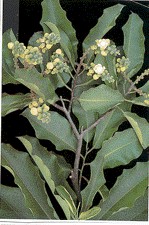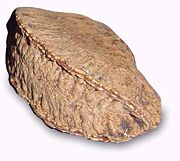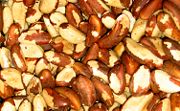Brazil nut
| Brazil nut | ||||||||||||||
|---|---|---|---|---|---|---|---|---|---|---|---|---|---|---|
 |
||||||||||||||
| Conservation status | ||||||||||||||
|
Vulnerable (IUCN 2.3) |
||||||||||||||
| Scientific classification | ||||||||||||||
|
||||||||||||||
| Binomial name | ||||||||||||||
| Bertholletia excelsa Humb. & Bonpl. |
The Brazil nut (Bertholletia excelsa) is a South American tree in the family Lecythidaceae, and also the name of the tree's commercially harvested edible seed.
The Brazil nut tree is the only species in the monotypic genus Bertholletia. It is native to the Guianas, Venezuela, Brazil, eastern Colombia, eastern Peru and eastern Bolivia. It occurs as scattered trees in large forests on the banks of the Amazon, Rio Negro, and the Orinoco. The genus is named after the French chemist Claude Louis Berthollet.
The Brazil nut is a large tree, reaching 30–45 metres (100–150 ft) tall and 1–2 metres (3–6.5 ft) trunk diameter, among the largest of trees in the Amazon Rainforests. It may live for 500 years or more, and according to some authorities often reaches an age of 1,000 years.[1] The stem is straight and commonly unbranched for well over half the tree's height, with a large emergent crown of long branches above the surrounding canopy of other trees. The bark is grayish and smooth. The leaves are dry-season deciduous, alternate, simple, entire or crenate, oblong, 20–35 centimetre long and 10–15 centimetres broad. The flowers are small, greenish-white, in panicles 5–10 centimetres long; each flower has a two-parted, deciduous calyx, six unequal cream-colored petals, and numerous stamens united into a broad, hood-shaped mass.
Contents |
Reproduction
Brazil nut trees produce fruit almost exclusively in pristine forests, as disturbed forests lack the large-body bees of the genera Bombus, Centris, Epicharis, Eulaema, and Xylocopa which are the only ones capable of pollinating the tree's flowers.[2][3] Brazil nuts have been harvested from plantations but production is low and it is currently not economically viable.[4][5][6]
The Brazil nut tree's yellow flowers contain very sweet nectar and can only be pollinated by an insect strong enough to lift the coiled hood on the flower and with tongues long enough to negotiate the complex coiled flower. The orchids produce a scent that attracts small male long-tongued orchid bees (Euglossa spp), as the male bees need that scent to attract females. The large female long-tongued orchid bee pollinates the Brazil nut tree. Without the orchid, the bees do not mate, and therefore the lack of bees means the fruit does not get pollinated.
If both the orchids and the bees are present, the fruit takes 14 months to mature after pollination of the flowers. The fruit itself is a large capsule 10–15 centimetres diameter resembling a coconut endocarp in size and weighing up to 2 kilograms. It has a hard, woody shell 8–12 millimetres thick, and inside contains 8–24 triangular seeds 4–5 centimetres long (the "Brazil nuts") packed like the segments of an orange; it is not a true nut in the botanical sense.
The capsule contains a small hole at one end, which enables large rodents like the Agouti to gnaw it open. They then eat some of the nuts inside while burying others for later use; some of these are able to germinate to produce new Brazil nut trees. Most of the seeds are "planted" by the Agoutis in shady places, and the young saplings may have to wait years, in a state of dormancy, for a tree to fall and sunlight to reach it. It is not until then that it starts growing again. Capuchin monkeys have been reported to open Brazil nuts using a stone as an anvil.
Nomenclature
Despite their name, the most significant exporter of Brazil nuts is not Brazil but Bolivia, where they are called almendras. In Brazil these nuts are called castanhas-do-Pará (literally "chestnuts from Pará"), but Acreans call them castanhas-do-Acre instead. Indigenous names include juvia in the Orinoco area, and sapucaia in the rest of Brazil.
Cream nuts is one of the several historical names used for Brazil nuts in America.
While cooks classify the Brazil nut as a nut, botanists consider it to be a seed and not a nut, since in nuts the shell splits in half with the meat separate from the shell.
Nut production


Around 20,000 tonnes of Brazil nuts are harvested each year, of which Bolivia accounts for about 50%, Brazil 40% and Peru 10% (2000 estimates).[7] In 1980, annual production was around 40,000 tons per year from Brazil alone, and in 1970 Brazil harvested a reported 104,487 tons of nuts.[8]
Effects of harvesting
Brazil nuts for international trade come entirely from wild collection rather than from plantations. This has been advanced as a model for generating income from a tropical forest without destroying it. The nuts are gathered by migrant workers known as castanheiros.
Analysis of tree ages in areas that are harvested show that moderate and intense gathering takes so many seeds that not enough are left to replace older trees as they die. Sites with light gathering activities had many young trees, while sites with intense gathering practices had hardly any young trees.[9]
Statistical tests were done to determine what environmental factors could be contributing to the lack of younger trees. The most consistent effect was found to be the level of gathering activity at a particular site. A computer model predicting the size of trees where people picked all the nuts matched the tree size data that was gathered from physical sites that had heavy harvesting.
Uses

Nutrition
Brazil nuts are 18% protein, 13% carbohydrates, and 69% fat. The fat breakdown is roughly 25% saturated, 41% monounsaturated, and 34% polyunsaturated.[10] The saturated fat content of Brazil nuts is among the highest of all nuts, surpassing even macadamia nuts, and are pressed for their oil. Because of the resulting rich taste, Brazil nuts can often substitute for macadamia nuts or even coconut in recipes. Also due to their high fat content, shelled Brazil nuts soon become rancid.
Nutritionally, Brazil nuts are a good source of magnesium and thiamine, and are perhaps the richest dietary source of selenium, containing as much as 1180% of the USRDV, although the amount of selenium within batches of nuts varies greatly.[11] Recent research suggests that proper selenium intake is correlated with a reduced risk of both breast cancer as well as prostate cancer.[12] This has led some commentators to recommend the consumption of Brazil nuts as a protective measure.[13] These findings are inconclusive, however; other investigations into the effects of selenium on prostate cancer were inconclusive.[14]
Despite the possible health benefits of the nut, the European Union has imposed strict regulations on the import from Brazil of Brazil nuts in their shells, as the shells have been found to contain high levels of aflatoxins, which can lead to liver cancer.[15] According to Tony Farndell, MD of TFR Nuts and Dried Fruits Ltd, a UK importer, the import restrictions on in-shell kernels came as a result of the whole nut including the shell, being ground down for testing. Thus aflatoxins were detected and the restrictions imposed.
Brazil nuts also contain small amounts of radioactive radium. Although the amount of radium is very small, about 1–7 pCi/g (40–260 Bq/kg), and most of it is not retained by the body, this is 1,000 times higher than in other foods. According to Oak Ridge Associated Universities, this is not because of elevated levels of radium in the soil, but due to "the very extensive root system of the tree."[16]
Other uses
As well as its food use, Brazil nut oil is also used as a lubricant in clocks, for making artists' paints, and in the cosmetics industry.
The timber from Brazil nut trees (not to be confused with Brazilwood) is of excellent quality, but logging the trees is prohibited by law in all three producing countries (Brazil, Bolivia and Peru). Illegal extraction of timber and land clearances present a continuing threat.[17]
The Brazil nut effect describes the tendency of the larger items to rise to the top of a mixture of items of various sizes but similar densities, e.g., Brazil nuts mixed with peanuts.
See also
- Official list of endangered flora of Brazil
References
- ↑ Harvesting nuts, improving lives in Brazil, Bruno Taitson, WWF, 18 January 2007
- ↑ Nelson, B.W.; Absy, M.L.; Barbosa, E.M.; Prance, G.T. (1985). "Observations on flower visitors to Bertholletia excelsa H. B. K. and Couratari tenuicarpa A. C. Sm.(Lecythidaceae).". Acta Amazonica 15 (1): 225–234. http://www.csa.com/partners/viewrecord.php?requester=gs&collection=ENV&recid=1566670. Retrieved on 2008-04-08.
- ↑ Moritz, A. (1984). Estudos biológicos da floração e da frutificação da castanha-do-Brasil (Bertholletia excelsa HBK). 29. http://orton.catie.ac.cr/cgi-bin/wxis.exe/?IsisScript=ACERVO.xis&method=post&formato=2&cantidad=1&expresion=mfn=029738. Retrieved on 2008-04-08.
- ↑ Brazil Nut Plantations
- ↑ The Brazil Nut (Bertholletia excelsa)
- ↑ The Brazil Nut Tree: More than just nuts
- ↑ Economic Viability of Brazil Nut Trading in Peru Chris Collinson et al, University of Greenwich
- ↑ The Brazil Nut Industry — Past, Present, and Future, Scott A. Mori, The New York Botanical Garden
- ↑ http://dx.doi.org/10.1016/j.tree.2004.03.022
- ↑ "USDA National Nutrient Database for Standard Reference, release 21 (2008)", United States Department of Agriculture - Agricultural Research Service
- ↑ Chang, Jacqueline C.; Walter H. Gutenmann, Charlotte M. Reid, Donald J. Lisk (1995). "Selenium content of Brazil nuts from two geographic locations in Brazil". Chemosphere 30 (4): 801–802. doi:. 0045-6535.
- ↑ Klein EA, Thompson IM, Lippman SM, Goodman PJ, Albanes D, Taylor PR, Coltman C., "SELECT: the next prostate cancer prevention trial. Selenum and Vitamin E Cancer Prevention Trial.", J Urol. 2001 Oct;166(4):1311-5. [PMID 11547064]
- ↑ Cancer Decisions Newsletter Archive, Selenium, Brazil Nuts and Prostate Cancer, [1] last accessed 8 March 2007
- ↑ Peters U, Foster CB, Chatterjee N, Schatzkin A, Reding D, Andriole GL, Crawford ED, Sturup S, Chanock SJ, Hayes RB. "Serum selenium and risk of prostate cancer-a nested case-control study." Am J Clin Nutr. 2007 Jan;85(1):209-17. [PMID 17209198]
- ↑ "Commission decision of 4 July 2003 imposing special conditions on the import of Brazil nuts in shell originating in or consigned from Brazil", Official Journal of the European Union, at Food Safety Authority of Ireland website
- ↑ Radioactivity of Brazil nuts. http://www.orau.org/PTP/collection/consumer%20products/brazilnuts.htm
- ↑ Activists Trapped by Loggers in Amazon, Greenpeace, 18 October 2007
External links
- INC, International Nut and Dried Fruit Council Foundation
- Americas Regional Workshop (Conservation & Sustainable Management of Trees, Costa Rica, November 1996) (1998). Bertholletia excelsa. 2006 IUCN Red List of Threatened Species. IUCN 2006. Retrieved on 9 May 2006. Listed as Vulnerable (VU A1acd+2cd v2.3)
- Peres, C.A. et al. (2003). "Demographic threats to the sustainability of Brazil nut exploitation". Science 302 (December 19): 2112–2114. doi:. PMID 14684819. (Overharvesting of Brazil nuts as threat to regeneration.)
- Brazil Nut homepage
- New York Botanical Gardens Brazil Nuts Page
- Brazil nuts' path to preservation, BBC News.
- Brazil nut, The Encyclopedia of Earth
- [2]
- This article incorporates text from the public domain 1911 edition of The Grocer's Encyclopedia.